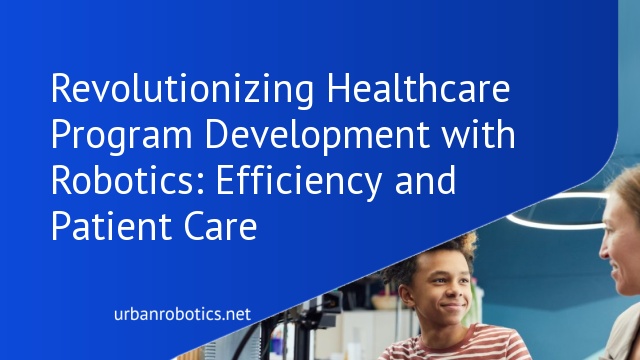Understanding Healthcare Program Development
Developing effective healthcare programs is crucial for delivering patient-centered medical care and leveraging robotics.
Overview of Healthcare Programs
Healthcare programs cover a range of services designed to maintain or improve health. They include preventive care, chronic disease management, and surgical interventions. These programs involve healthcare providers, patients, and technology to ensure comprehensive care. Robotics enhances these programs by improving precision, reducing human errors, and optimizing resource utilization.
Importance of Program Development
Program development is vital for adapting to evolving healthcare needs. It ensures that services are efficient, scalable, and responsive to patient demands. Effective development involves integrating the latest technologies, like robotics, to enhance care quality. By refining healthcare programs, we can achieve better health outcomes and streamlined clinical processes.
The Role of Robotics in Healthcare
Robotics is pivotal in transforming healthcare. By enhancing precision, efficiency, and outcomes, robotics is redefining medical program development.
Types of Robotics in Healthcare
Different types of robotics are being utilized across healthcare. Surgical robots like the da Vinci system aid in minimally invasive surgery. Rehabilitation robots assist patients in recovery post-stroke or injury. Service robots manage tasks like medication delivery within hospitals. Diagnostic robots help in imaging and diagnosing conditions accurately. Each type addresses specific needs, contributing to improved patient care.
Current Applications of Robotics
Robotics applications in healthcare are extensive. Robots assist surgeons in performing complex procedures with improved accuracy. They help in automating repetitive tasks, reducing the burden on healthcare workers. Rehabilitation robots provide personalized therapy plans, speeding up recovery. Robots also play a role in patient monitoring, offering real-time data for better management. These applications demonstrate robotics’ significant impact on healthcare efficiency and effectiveness.
Benefits of Integrating Robotics
Integrating robotics into healthcare programs offers numerous advantages. These benefits significantly contribute to advancing the healthcare industry and improving patient care.
Improved Patient Outcomes
Robotics in healthcare improves patient outcomes by increasing surgical accuracy and reducing recovery times. For instance, surgical robots like the da Vinci system enable minimally invasive procedures, which result in fewer complications and shorter hospital stays. Rehabilitation robots customize patient therapy programs, ensuring consistent and effective treatments. We witness a significant enhancement in patient satisfaction and long-term health.
Enhanced Precision and Efficiency
Robotics enhances precision and efficiency in medical procedures by automating repetitive tasks and providing consistent performance. Diagnostic robots, for example, deliver accurate imaging, aiding in early detection and treatment of diseases. Service robots handle logistics, such as transporting supplies, reducing the burden on healthcare staff. This precision and efficiency lead to time savings and optimal resource utilization, elevating the overall quality of healthcare services.
Challenges and Considerations
Healthcare program development with robotics involves various challenges and considerations that need addressing for successful implementation.
Technical and Operational Barriers
Robotics in healthcare faces significant technical and operational barriers. Developing and maintaining advanced robotic systems requires substantial investment in both financial and human resources. Integrating these systems into existing healthcare infrastructure poses compatibility issues, often necessitating extensive customization. For example, robotic surgery systems may demand specialized training for surgeons and support staff, impacting their seamless adoption.
Ethical and Regulatory Issues
Ethical and regulatory issues also play a crucial role in the deployment of robotics in healthcare. Patient safety and data privacy must meet stringent standards. Regulatory bodies like the FDA have rigorous approval processes for new medical devices, including robotic systems, to ensure their safety and efficacy. Ethical considerations include addressing potential biases in robotic algorithms, which could affect patient outcomes. For instance, ensuring that diagnostic robots provide accurate results across diverse patient demographics is essential for equitable healthcare.
Future Prospects
The future of healthcare program development with robotics appears promising, given the rapid advancements in technology. Robotics are poised to revolutionize various aspects of healthcare services.
Emerging Technologies
Emerging technologies include AI-driven robotics, nanobots, and advanced prosthetics. AI-driven robotics enhance precision in surgical procedures and diagnostics. Nanobots, designed for precise drug delivery, can target disease more effectively. Advanced prosthetics, integrated with AI, offer improved mobility and functionality for amputees. These technologies promise significant enhancements in patient care and treatment outcomes.
Potential Innovations
Potential innovations involve integrating IoT with robotics for real-time health monitoring, VR and AR for remote surgeries, and blockchain for secure patient data management. IoT-enabled robotic systems streamline continuous patient monitoring, improving response times. VR and AR facilitate telemedicine and remote surgical training. Blockchain ensures data integrity and privacy, optimizing data sharing among healthcare providers securely.
Conclusion
The integration of robotics in healthcare program development is transforming the industry. By leveraging advanced technologies like AI, nanobots, and VR we can significantly enhance patient care and treatment outcomes. Despite challenges such as technical barriers and ethical considerations the potential benefits far outweigh the obstacles. As we continue to innovate and address these issues the future of healthcare with robotics looks incredibly promising. Let’s embrace these advancements to create a more efficient accurate and patient-centric healthcare system.





